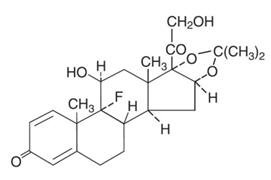Juulissa
Generic name:triamcinolone acetonide
Dosage form: kit
Drug class:Topical steroids
Medically reviewed by Drugs.com. Last updated on Nov 1, 2020.
Disclaimer: This drug has not been found by FDA to be safe and effective, and this labeling has not been approved by FDA. For further information about unapproved drugs, click here.
On This Page
Triamcinolone Acetonide Ointment USP, 0.1%
Juulissa Description
The topical corticosteroids constitute a class of primarily synthetic steroids used as anti- inflammatory and antipruritic agents. The steroids in this class include triamcinolone acetonide. Triamcinolone acetonide is designated chemically as 9-Fluoro-11β, 16α, 17,21-tetrahydroxypregna-1,4-diene-3,20-dione cyclic 16,17-acetal with acetone. C 24H 31FO 6. M.W. 434.51; CAS Reg. No. 76-25-5.

Each gram of Triamcinolone Acetonide Ointment USP, 0.1% contains 1mg triamcinolone acetonide in an ointment base of light mineral oil and white petrolatum.
Juulissa - Clinical Pharmacology
Topical corticosteroids share anti- inflammatory, antipruritic and vasoconstrictive actions. The mechanism of anti- inflammatory activity of the topical corticosteroids is unclear. Various laboratory methods, including vasoconstrictor assays, are used to compare and predict potencies and/or clinical efficacies of the topical corticosteroids. There is some evidence to suggest that a recognizable correlation exists between vasoconstrictor potency and therapeutic efficacy in man.
Pharmacokinetics -
The extent of percutaneous absorption of topical corticosteroids is determined by many factors including the vehicle, the integrity of the epidermal barrier, and the use of occlusive dressings. Topical corticosteroids can be absorbed from normal intact skin. Inflammation and/or other disease processes in the skin increase percutaneous absorption. Occlusive dressings substantially increase the percutaneous absorption of topical corticosteroids.Thus, occlusive dressings may be a valuable ...



